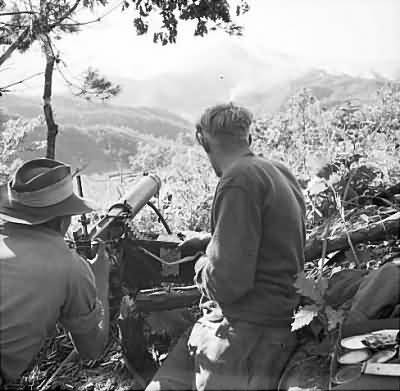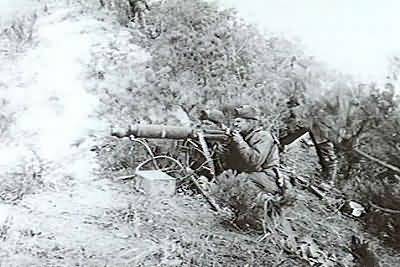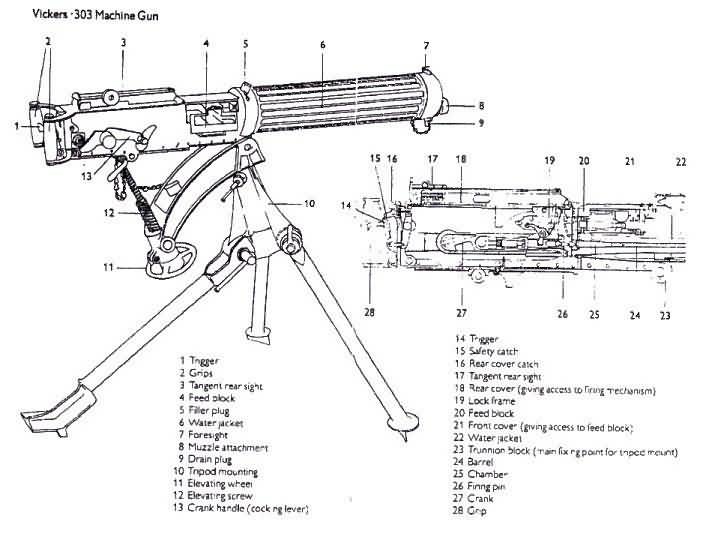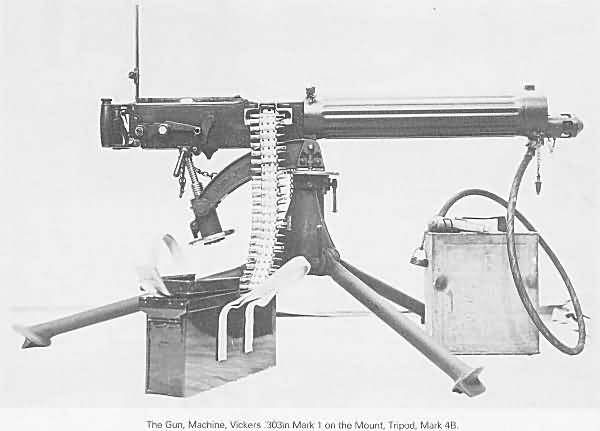The Vickers machine-gun, the standard water-cooled weapon, remained in service for Great Britain until 1968. It was the medium machine gun used by all British Commonwealth forces in the Korean War, although Australian forces occasionally used the US .30 A4.
Continuous automatic fire generated tremendous heat in the barrel and Maxim overcame this problem by encasing the barrel in a water jacket, containing about 7.5 pints. Heat from continuous firing caused the water to boil, the steam indicating the gun's position. Attaching a tube from a vent in the jacket into a can of water condensed the steam and helped conceal the gun's position. The water-can also helped resupply the jacket, since there was an evaporation rate of about 1.5 pints per 1,000 rounds fired.
| Operation | Fully automatic, recoil operated, water-cooled |
| Caliber | .303in |
| Ammunition | Mk 8z ball; 174 gr bullet, 36.5 gr charge |
| Muzzle velocity | 2400 fps |
| Capacity | 250-round fabric belt, 22 lb. with box |
| Weight | Unloaded, 40 lb. |
| Overall length | 45.5 in |
| Rate of fire | 450 rounds per minute |
| Effective range | 4000m with Mk 8z, (2000m with Mk 7)
|
The Vickers machine-gun was an inprovement on the original Maxim. The main difference lies in the fact that the toggle locking action was inverted, but the weight was also considerably reduced by careful stress calculations and by the use of good grade steel and aluminium. The gun was adopted by the British Army in November 1912, and remained as the standard support-fire machine gun until the middle 1960s, when it was replaced by the L7A1 GPMG. In its time, the Vickers pattern went through twelve or more modifications, mostly minor, and was substantially the same gun after fifty years of service. It was heavy, fairly slow-firing, prone to a number of stoppages from the ammunition, but reliable in itself and well loved by all but the enemy. It worked in the most adverse conditions, and its water-cooled barrel ensured long life for the bore by helping to maintain low temperature. It was used in aircraft (for which it was air-cooled), in ships, in tanks, as a ground AA gun, on armoured trains, on armoured cars, and in a host of other roles.

A Vickers gun crew lay down covering fire for 3rd Battalion Royal Australian Regiment during the assault on Hill 317, the battle of Maryang San.

Chipyong-ni, Korea, February 1951. A Vickers .303 machine-gun in action against the Chinese, manned by Sergeant Chaperlin, 3 RAR.
The two photos immediately above provided courtesy of the Australian War Memorial
The machine gunner usually fired from a sitting position, holding two wooden grips which were fixed at the rear of the gun. Between the grips was a thumb operated trigger with a safety catch. This catch had to be lifted up before the thumb piece could be pressed. The grips were hollow. One contained a brass oil bottle, the other an oil brush.

Vickers component parts


